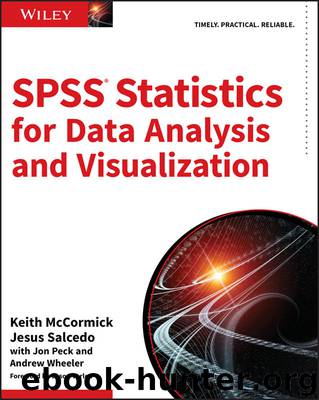SPSS Statistics for Data Analysis and Visualization by Keith McCormick & Jesus Salcedo

Author:Keith McCormick & Jesus Salcedo [McCormick, Keith]
Language: eng
Format: azw3
ISBN: 9781119003663
Publisher: Wiley
Published: 2017-04-17T04:00:00+00:00
Figure 9.1 Culture and sport perceptual map
Contains public sector information licensed under the Open Government Licence v3.0. (https://www.nationalarchives.gov.uk/doc/ open-government-licence/version/3/)
Starting with Crosstabs
Now let’s get to work in SPSS Statistics. We will be using a modified version of the LeRoux and Rouanet dataset. Our version is different in two ways from other versions you may find: The Multiple Imputation feature of SPSS Statistics has been used to replace the missing Income values, and AutoRecode has been used to replace the string values with numeric values and labels. The version of the data that we will be using is called Taste_Imputed.sav, which is available on the book’s website.
We will begin with Correspondence Analysis. The trick in selecting appropriate variables for this technique is to remember a couple of key points. First, Correspondence Analysis allows just two variables: a row variable and a column variable. Second, the whole point of the technique is to display on two dimensions information that otherwise would be difficult to display on two dimensions. So, if you only have a 2x2 crosstabulation matrix you don’t need it. Also, if you have strong linear associations between two ordinal variables you can probably visualize that with less effort. The variables most appropriate will be a pair of nominal variables with several categories. While there is no rule that we must pair a demographic variable with a behavioral variable, it is an approach that is quite common. For instance, if you are a film studio, you might want to know which demographic patterns are associated with film attendance. While it might also be quite interesting to relate film preference with concert attendance, it might not be as immediately actionable as the demographics. With this in mind, we will set up the Crosstabs menu with TV, Film, Art, and Eat in rows, and Income and Age in Columns (Figure 9.2).
Download
This site does not store any files on its server. We only index and link to content provided by other sites. Please contact the content providers to delete copyright contents if any and email us, we'll remove relevant links or contents immediately.
Algorithms of the Intelligent Web by Haralambos Marmanis;Dmitry Babenko(16237)
Azure Data and AI Architect Handbook by Olivier Mertens & Breght Van Baelen(7676)
Building Statistical Models in Python by Huy Hoang Nguyen & Paul N Adams & Stuart J Miller(7658)
Serverless Machine Learning with Amazon Redshift ML by Debu Panda & Phil Bates & Bhanu Pittampally & Sumeet Joshi(7531)
Driving Data Quality with Data Contracts by Andrew Jones(7294)
Data Wrangling on AWS by Navnit Shukla | Sankar M | Sam Palani(7291)
Machine Learning Model Serving Patterns and Best Practices by Md Johirul Islam(7032)
Learning SQL by Alan Beaulieu(6239)
Weapons of Math Destruction by Cathy O'Neil(6220)
Big Data Analysis with Python by Ivan Marin(5937)
Data Engineering with dbt by Roberto Zagni(4933)
Solidity Programming Essentials by Ritesh Modi(4568)
Time Series Analysis with Python Cookbook by Tarek A. Atwan(4402)
Pandas Cookbook by Theodore Petrou(4088)
Blockchain Basics by Daniel Drescher(3544)
Natural Language Processing with Java Cookbook by Richard M. Reese(3146)
Hands-On Machine Learning for Algorithmic Trading by Stefan Jansen(3049)
Learn T-SQL Querying by Pam Lahoud & Pedro Lopes(2931)
Feature Store for Machine Learning by Jayanth Kumar M J(2928)
